中考英语形容词副词比较级总复习教案.doc
- 格式:doc
- 大小:58.50 KB
- 文档页数:8
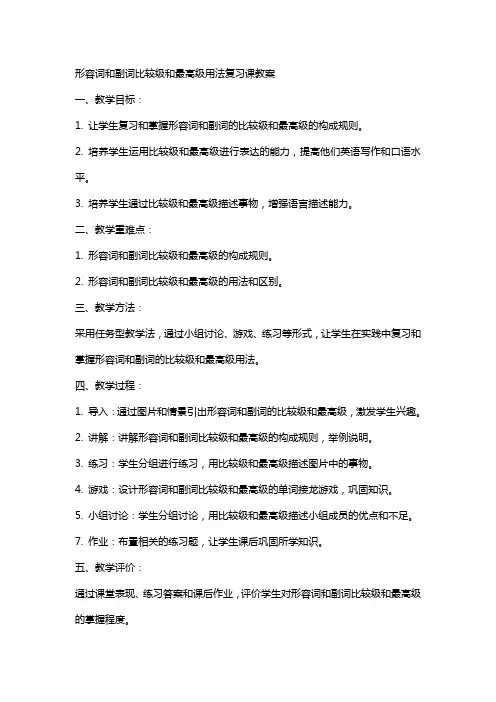
形容词和副词比较级和最高级用法复习课教案一、教学目标:1. 让学生复习和掌握形容词和副词的比较级和最高级的构成规则。
2. 培养学生运用比较级和最高级进行表达的能力,提高他们英语写作和口语水平。
3. 培养学生通过比较级和最高级描述事物,增强语言描述能力。
二、教学重难点:1. 形容词和副词比较级和最高级的构成规则。
2. 形容词和副词比较级和最高级的用法和区别。
三、教学方法:采用任务型教学法,通过小组讨论、游戏、练习等形式,让学生在实践中复习和掌握形容词和副词的比较级和最高级用法。
四、教学过程:1. 导入:通过图片和情景引出形容词和副词的比较级和最高级,激发学生兴趣。
2. 讲解:讲解形容词和副词比较级和最高级的构成规则,举例说明。
3. 练习:学生分组进行练习,用比较级和最高级描述图片中的事物。
4. 游戏:设计形容词和副词比较级和最高级的单词接龙游戏,巩固知识。
5. 小组讨论:学生分组讨论,用比较级和最高级描述小组成员的优点和不足。
7. 作业:布置相关的练习题,让学生课后巩固所学知识。
五、教学评价:通过课堂表现、练习答案和课后作业,评价学生对形容词和副词比较级和最高级的掌握程度。
六、教学活动设计:1. 情景剧:学生分组,编写关于日常生活中使用形容词和副词比较级和最高级的对话,进行表演。
2. 竞赛:设计形容词和副词比较级和最高级的知识竞赛,激发学生学习兴趣。
3. 写作练习:让学生写一篇短文,用比较级和最高级描述一个他们熟悉的人物或物体。
七、教学资源:1. 图片:用于引导学生直观地理解形容词和副词比较级和最高级的用法。
2. 练习题:用于巩固和检测学生对知识的掌握。
3. 教学课件:展示形容词和副词比较级和最高级的用法和例子。
八、教学反馈:1. 课堂问答:通过提问,了解学生在课堂上的参与度和理解程度。
2. 练习批改:及时批改学生的练习,给予反馈和指导。
3. 课后作业:检查学生作业,评估他们对知识的掌握情况。
九、教学拓展:1. 让学生运用形容词和副词比较级和最高级描述家庭成员,进行家庭作业。
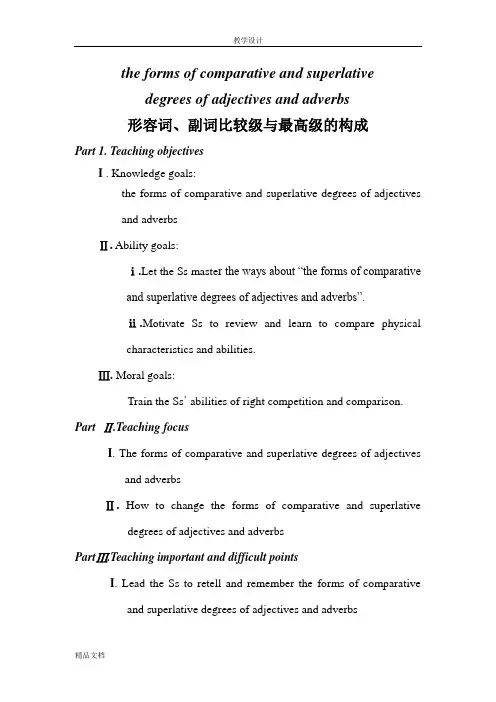
the forms of comparative and superlativedegrees of adjectives and adverbs形容词、副词比较级与最高级的构成Part 1.Teaching objectivesI . Knowledge goals:the forms of comparative and superlative degrees of adjectivesand adverbsⅡ. Ability goals:ⅰ.Let the Ss maste r the ways about “the forms of comparativeand superlative degrees of adjectives and adverbs”.ⅱ.Motivate Ss to review and learn to compare physicalcharacteristics and abilities.Ⅲ. Moral goals:Train the Ss` abilities of right competition and comparison. Part Ⅱ.Teaching focusI. The forms of comparative and superlative degrees of adjectivesand adverbsⅡ.How to change the forms of comparative and superlative degrees of adjectives and adverbsPartⅢ.Teaching important and difficult pointsI. Lead the Ss to retell and remember the forms of comparativeand superlative degrees of adjectives and adverbsⅡ.How to train the Ss to use the forms freely.Part Ⅳ. Teaching aidsI. Multi-mediaⅡ. The blackboardⅢ. Some picturesPart Ⅴ. Teaching ProceduresStep 1 GreetingGreet the Ss and make introduction myself to teachers and Ss. Step 2 Lead-inⅰ.Show some pictures on ppt. to lead the Ss to comparesomething.ⅱ.Guide Ss to know how to change adjectives intocomparative and superlative degrees.ⅲ. Ask Ss to guess what we have in this class.Step3.PresentationⅠ.I write the key words on the Bb while Ss look at the pictures.Let`s do a guessing—game .Ss:形容词、副词比较级与最高级的构成T: You are very clever.So I show the title of this lesson“the forms of comparative and superlative degrees of adjectives and adverbs.”Ⅱ.I’ll use ppt. to present the content. Arrange some situations to help Ss understand.Ⅲ.Let the Ss to Continue look at the pictures. At the same time,I write the key words on the Bb. while Ss are watching thepictures.After watching, I’ll teach them to read the words and vocabularies on the Bb. Make sure they can read them well. then, ask the Ss :T: Do you find out the rules of these words?Ss: 1 .一般情况下直接在词尾加er或est.2.以字母e结尾的在词尾加r或st.3.以辅音字母加y结尾的变y为i再加er; est4.在重读闭音节结尾且末尾只有一个辅音字母的,要双写末尾的辅音字母再加er; estⅣ.Let the Ss to Continue look at the pictures. At the same time, I write the key words on the Bb. while Ss are watching the pictures.Ss: 多音节词和部分双音节词在原级前加more或most Ⅴ.Let the Ss to Continue look at the pictures. At the same time,I write the key words on the Bb. while Ss are watching thepictures.T: Do you find out the rules of these words?Ss: 这些是不规则变化形式。
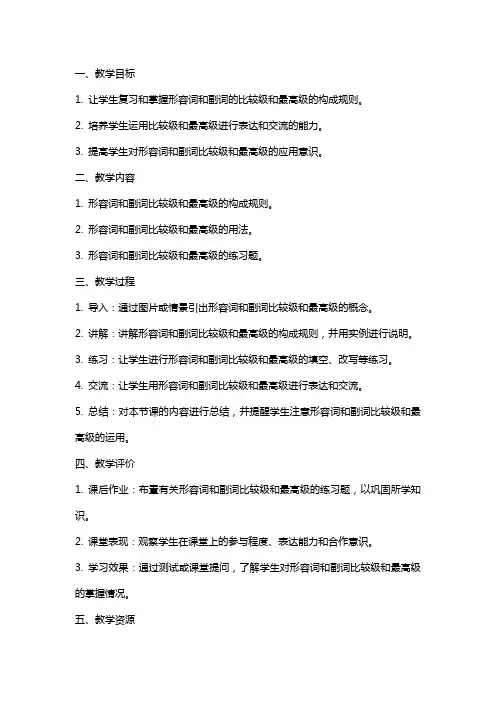
一、教学目标1. 让学生复习和掌握形容词和副词的比较级和最高级的构成规则。
2. 培养学生运用比较级和最高级进行表达和交流的能力。
3. 提高学生对形容词和副词比较级和最高级的应用意识。
二、教学内容1. 形容词和副词比较级和最高级的构成规则。
2. 形容词和副词比较级和最高级的用法。
3. 形容词和副词比较级和最高级的练习题。
三、教学过程1. 导入:通过图片或情景引出形容词和副词比较级和最高级的概念。
2. 讲解:讲解形容词和副词比较级和最高级的构成规则,并用实例进行说明。
3. 练习:让学生进行形容词和副词比较级和最高级的填空、改写等练习。
4. 交流:让学生用形容词和副词比较级和最高级进行表达和交流。
5. 总结:对本节课的内容进行总结,并提醒学生注意形容词和副词比较级和最高级的运用。
四、教学评价1. 课后作业:布置有关形容词和副词比较级和最高级的练习题,以巩固所学知识。
2. 课堂表现:观察学生在课堂上的参与程度、表达能力和合作意识。
3. 学习效果:通过测试或课堂提问,了解学生对形容词和副词比较级和最高级的掌握情况。
五、教学资源1. 图片或情景:用于导入和激发学生兴趣。
2. 练习题:用于巩固所学知识,提高学生的应用能力。
3. 教学PPT:用于展示和讲解形容词和副词比较级和最高级的知识。
4. 参考资料:为学生提供更多的学习资源和拓展知识。
六、教学策略1. 任务型教学法:通过设计各种任务,让学生在实践中运用形容词和副词比较级和最高级。
2. 合作学习:鼓励学生分组讨论和完成练习,培养学生的团队合作能力。
3. 交际式教学法:通过角色扮演、小组讨论等形式,提高学生的口语表达能力和交际能力。
4. 直观教学法:利用图片、实物等直观教具,帮助学生更好地理解和记忆形容词和副词比较级和最高级。
七、教学重点与难点1. 教学重点:形容词和副词比较级和最高级的构成规则、用法和练习。
2. 教学难点:形容词和副词比较级和最高级的运用,特别是在实际语境中的运用。
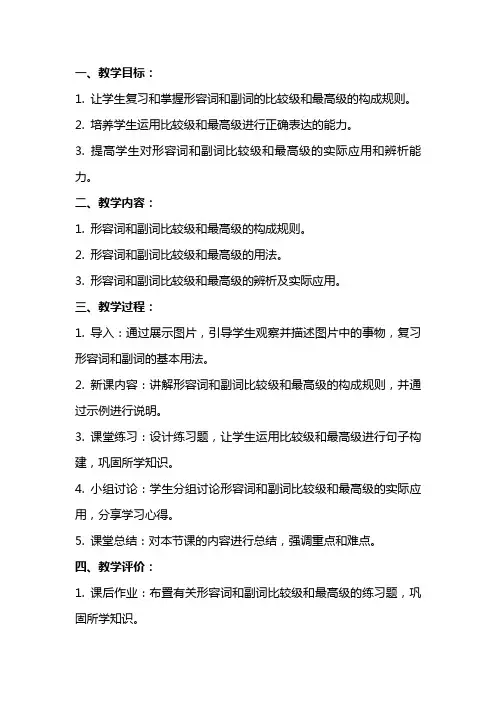
一、教学目标:1. 让学生复习和掌握形容词和副词的比较级和最高级的构成规则。
2. 培养学生运用比较级和最高级进行正确表达的能力。
3. 提高学生对形容词和副词比较级和最高级的实际应用和辨析能力。
二、教学内容:1. 形容词和副词比较级和最高级的构成规则。
2. 形容词和副词比较级和最高级的用法。
3. 形容词和副词比较级和最高级的辨析及实际应用。
三、教学过程:1. 导入:通过展示图片,引导学生观察并描述图片中的事物,复习形容词和副词的基本用法。
2. 新课内容:讲解形容词和副词比较级和最高级的构成规则,并通过示例进行说明。
3. 课堂练习:设计练习题,让学生运用比较级和最高级进行句子构建,巩固所学知识。
4. 小组讨论:学生分组讨论形容词和副词比较级和最高级的实际应用,分享学习心得。
5. 课堂总结:对本节课的内容进行总结,强调重点和难点。
四、教学评价:1. 课后作业:布置有关形容词和副词比较级和最高级的练习题,巩固所学知识。
2. 课堂表现:观察学生在课堂上的参与程度、回答问题的情况,了解学生的学习效果。
3. 小组讨论:评估学生在小组讨论中的表现,包括表达能力、合作精神等。
五、教学资源:1. 教学PPT:展示形容词和副词比较级和最高级的构成规则、用法和练习题。
2. 图片:用于导入课堂,激发学生兴趣。
3. 练习题:设计有关形容词和副词比较级和最高级的练习题,巩固所学知识。
4. 小组讨论:组织学生进行小组讨论,促进互动和合作学习。
六、教学策略:1. 案例分析:通过具体案例分析,让学生深入了解形容词和副词比较级和最高级的应用场景。
2. 互动教学:采用提问、回答、讨论等方式,激发学生的思考,提高课堂互动性。
3. 任务型教学:设计任务让学生完成,培养学生实际运用比较级和最高级进行表达的能力。
七、教学步骤:1. 复习形容词和副词的基本用法,通过展示图片引导学生描述图片中的事物。
2. 讲解比较级和最高级的构成规则,并通过示例进行说明。
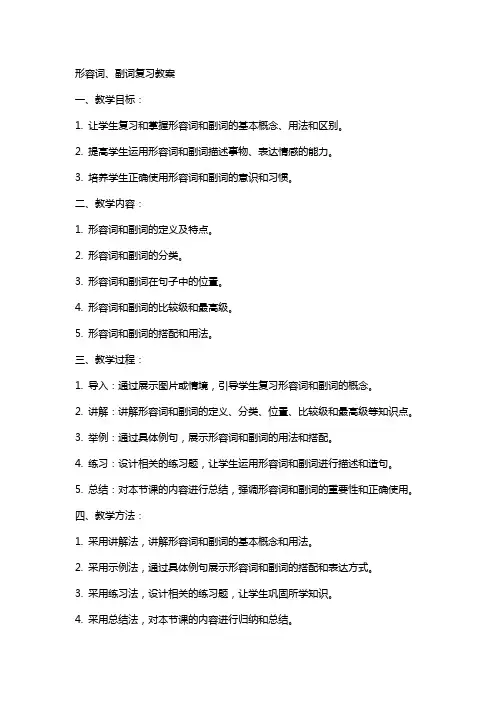
形容词、副词复习教案一、教学目标:1. 让学生复习和掌握形容词和副词的基本概念、用法和区别。
2. 提高学生运用形容词和副词描述事物、表达情感的能力。
3. 培养学生正确使用形容词和副词的意识和习惯。
二、教学内容:1. 形容词和副词的定义及特点。
2. 形容词和副词的分类。
3. 形容词和副词在句子中的位置。
4. 形容词和副词的比较级和最高级。
5. 形容词和副词的搭配和用法。
三、教学过程:1. 导入:通过展示图片或情境,引导学生复习形容词和副词的概念。
2. 讲解:讲解形容词和副词的定义、分类、位置、比较级和最高级等知识点。
3. 举例:通过具体例句,展示形容词和副词的用法和搭配。
4. 练习:设计相关的练习题,让学生运用形容词和副词进行描述和造句。
5. 总结:对本节课的内容进行总结,强调形容词和副词的重要性和正确使用。
四、教学方法:1. 采用讲解法,讲解形容词和副词的基本概念和用法。
2. 采用示例法,通过具体例句展示形容词和副词的搭配和表达方式。
3. 采用练习法,设计相关的练习题,让学生巩固所学知识。
4. 采用总结法,对本节课的内容进行归纳和总结。
五、教学评价:1. 课堂参与度:观察学生在课堂上的发言和参与情况,了解学生的学习积极性。
2. 练习完成情况:检查学生完成的练习题,评估学生对形容词和副词的掌握程度。
3. 学生作品:让学生运用形容词和副词进行写作,评估学生的实际运用能力。
4. 课后反馈:收集学生的课后反馈,了解学生对教学内容的掌握情况。
六、教学资源:1. 教材或教学指导书:提供形容词和副词的相关知识点和练习题。
2. PPT或教学课件:通过图片、动画等形式展示形容词和副词的用法和搭配。
3. 练习题:设计相关的练习题,巩固学生对形容词和副词的掌握。
4. 学生作品展示:展示学生运用形容词和副词进行写作的作品。
七、教学步骤:1. 导入:通过展示图片或情境,引导学生复习形容词和副词的概念。
2. 讲解:讲解形容词和副词的定义、分类、位置、比较级和最高级等知识点。
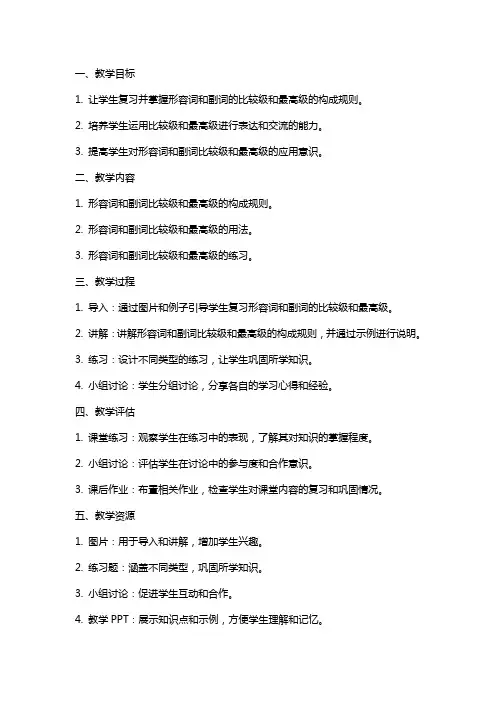
1. 让学生复习并掌握形容词和副词的比较级和最高级的构成规则。
2. 培养学生运用比较级和最高级进行表达和交流的能力。
3. 提高学生对形容词和副词比较级和最高级的应用意识。
二、教学内容1. 形容词和副词比较级和最高级的构成规则。
2. 形容词和副词比较级和最高级的用法。
3. 形容词和副词比较级和最高级的练习。
三、教学过程1. 导入:通过图片和例子引导学生复习形容词和副词的比较级和最高级。
2. 讲解:讲解形容词和副词比较级和最高级的构成规则,并通过示例进行说明。
3. 练习:设计不同类型的练习,让学生巩固所学知识。
4. 小组讨论:学生分组讨论,分享各自的学习心得和经验。
四、教学评估1. 课堂练习:观察学生在练习中的表现,了解其对知识的掌握程度。
2. 小组讨论:评估学生在讨论中的参与度和合作意识。
3. 课后作业:布置相关作业,检查学生对课堂内容的复习和巩固情况。
五、教学资源1. 图片:用于导入和讲解,增加学生兴趣。
2. 练习题:涵盖不同类型,巩固所学知识。
3. 小组讨论:促进学生互动和合作。
4. 教学PPT:展示知识点和示例,方便学生理解和记忆。
1. 案例分析:通过分析具体案例,让学生了解形容词和副词比较级和最高级在实际语境中的运用。
2. 句子构建:引导学生运用比较级和最高级构建句子,提高表达能力。
3. 游戏环节:设计形容词和副词比较级和最高级的游戏,增加课堂趣味性。
4. 角色扮演:学生分组进行角色扮演,运用比较级和最高级进行对话。
七、教学策略1. 情境教学:创设生活情境,让学生在实际语境中学习形容词和副词比较级和最高级。
2. 任务型教学:布置相关任务,让学生在完成任务的过程中运用所学知识。
3. 游戏化教学:通过游戏激发学生的学习兴趣,提高课堂参与度。
4. 交际型教学:鼓励学生进行互动交流,提高口语表达能力。
八、教学反馈1. 课堂问答:教师提问,学生回答,及时了解学生对知识的掌握程度。
2. 小组评价:学生互相评价,促进课堂互动和合作。
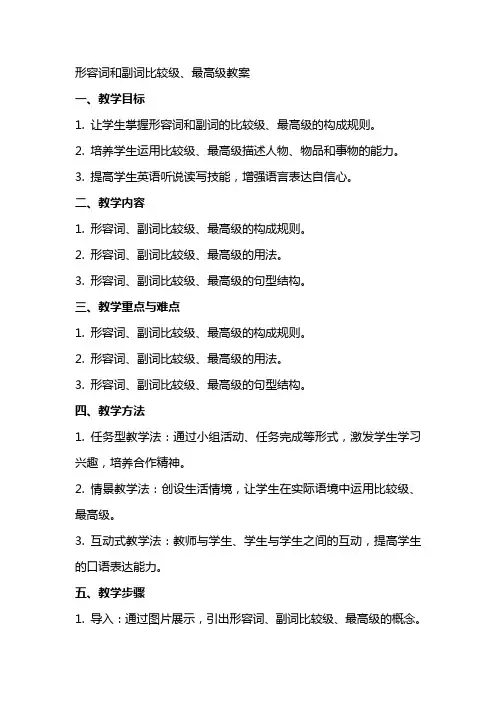
形容词和副词比较级、最高级教案一、教学目标1. 让学生掌握形容词和副词的比较级、最高级的构成规则。
2. 培养学生运用比较级、最高级描述人物、物品和事物的能力。
3. 提高学生英语听说读写技能,增强语言表达自信心。
二、教学内容1. 形容词、副词比较级、最高级的构成规则。
2. 形容词、副词比较级、最高级的用法。
3. 形容词、副词比较级、最高级的句型结构。
三、教学重点与难点1. 形容词、副词比较级、最高级的构成规则。
2. 形容词、副词比较级、最高级的用法。
3. 形容词、副词比较级、最高级的句型结构。
四、教学方法1. 任务型教学法:通过小组活动、任务完成等形式,激发学生学习兴趣,培养合作精神。
2. 情景教学法:创设生活情境,让学生在实际语境中运用比较级、最高级。
3. 互动式教学法:教师与学生、学生与学生之间的互动,提高学生的口语表达能力。
五、教学步骤1. 导入:通过图片展示,引出形容词、副词比较级、最高级的概念。
2. 讲解:讲解形容词、副词比较级、最高级的构成规则及用法。
3. 练习:进行分组练习,让学生在实际语境中运用比较级、最高级。
4. 拓展:引导学生运用比较级、最高级描述人物、物品和事物。
5. 总结:对本节课内容进行总结,强调比较级、最高级的重要性和运用。
教学评价:通过课堂表现、练习完成情况和课后作业,评估学生对形容词、副词比较级、最高级的掌握程度。
六、教学活动设计1. 小组竞赛:划分学生为若干小组,进行形容词和副词比较级、最高级的抢答竞赛。
2. 角色扮演:设计情境,让学生运用比较级、最高级进行角色扮演。
3. 写作练习:布置一篇以比较级、最高级描述人物的短文写作任务。
七、教学案例案例一:比较级、最高级在人物描述中的应用案例二:比较级、最高级在物品比较中的应用案例三:比较级、最高级在事物评价中的应用八、课后作业1. 完成练习册上的相关练习题。
2. 搜集生活中的形容词、副词比较级、最高级的例子,进行分享。
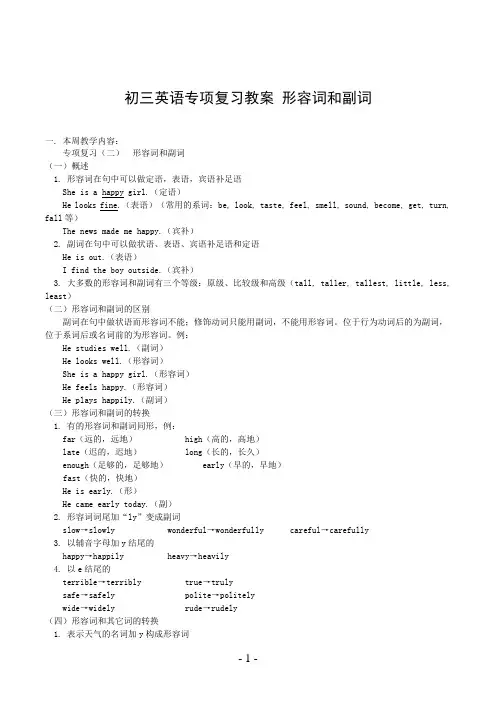
初三英语专项复习教案形容词和副词一. 本周教学内容:专项复习(二)形容词和副词(一)概述1. 形容词在句中可以做定语,表语,宾语补足语She is a happy girl.(定语)He looks fine.(表语)(常用的系词:be, look, taste, feel, smell, sound, become, get, turn, fall等)The news made me happy.(宾补)2. 副词在句中可以做状语、表语、宾语补足语和定语He is out.(表语)I find the boy outside.(宾补)3. 大多数的形容词和副词有三个等级:原级、比较级和高级(tall, taller, tallest, little, less, least)(二)形容词和副词的区别副词在句中做状语而形容词不能;修饰动词只能用副词,不能用形容词。
位于行为动词后的为副词,位于系词后或名词前的为形容词。
例:He studies well.(副词)He looks well.(形容词)She is a happy girl.(形容词)He feels happy.(形容词)He plays happily.(副词)(三)形容词和副词的转换1. 有的形容词和副词同形,例:far(远的,远地)high(高的,高地)late(迟的,迟地)long(长的,长久)enough(足够的,足够地)early(早的,早地)fast(快的,快地)He is early.(形)He came early today.(副)2. 形容词词尾加“ly”变成副词slow→slowly wonderful→wonderfully careful→carefully3. 以辅音字母加y结尾的happy→happily heavy→heavily4. 以e结尾的terrible→terribly true→trulysafe→safely polite→politelywide→widely rude→rudely(四)形容词和其它词的转换1. 表示天气的名词加y构成形容词could→cloudy wind→windy rain→rainysnow→snowy sun→sunny ice→icy(sun,ice比较特殊)2. 一些动词加ful构成形容词care→careful thank→thankful wonder→wonderfulforget→forgetful use→useful help→helpful3. 一些名词加ly变为形容词friend→friendly father→fatherly sister→sisterlymother→motherly love→lovely4. 有些动词后加able变成形容词enjoy→enjoyable comfort→comfortable5. 名词后加ous变成形容词danger→dangerous humor→humorous(五)区别几组易混淆的副词、形容词already常用于肯定句,个别疑问句,yet常用于否定句、疑问句such修饰名词,so修饰形容词、副词The train has already gone.They haven’t come back yet.I have never seen such an interesting film.This box is so heavy that I can’t carry it.alone(单独、独自)作表语=by oneselflonely(孤独的)可作表语、定语He lived alone, but he didn’t feel lonely.他一个人生活但并不觉得寂寞。
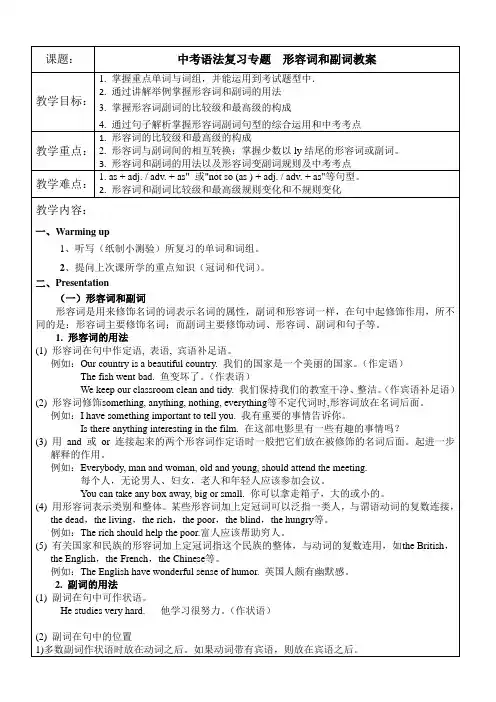
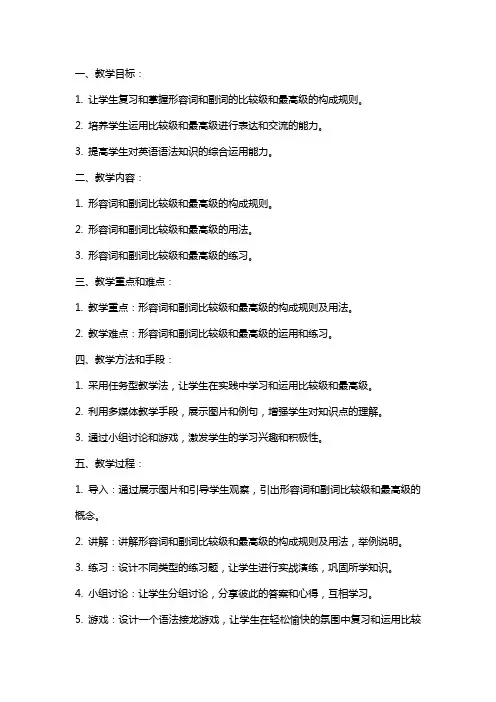
一、教学目标:1. 让学生复习和掌握形容词和副词的比较级和最高级的构成规则。
2. 培养学生运用比较级和最高级进行表达和交流的能力。
3. 提高学生对英语语法知识的综合运用能力。
二、教学内容:1. 形容词和副词比较级和最高级的构成规则。
2. 形容词和副词比较级和最高级的用法。
3. 形容词和副词比较级和最高级的练习。
三、教学重点和难点:1. 教学重点:形容词和副词比较级和最高级的构成规则及用法。
2. 教学难点:形容词和副词比较级和最高级的运用和练习。
四、教学方法和手段:1. 采用任务型教学法,让学生在实践中学习和运用比较级和最高级。
2. 利用多媒体教学手段,展示图片和例句,增强学生对知识点的理解。
3. 通过小组讨论和游戏,激发学生的学习兴趣和积极性。
五、教学过程:1. 导入:通过展示图片和引导学生观察,引出形容词和副词比较级和最高级的概念。
2. 讲解:讲解形容词和副词比较级和最高级的构成规则及用法,举例说明。
3. 练习:设计不同类型的练习题,让学生进行实战演练,巩固所学知识。
4. 小组讨论:让学生分组讨论,分享彼此的答案和心得,互相学习。
5. 游戏:设计一个语法接龙游戏,让学生在轻松愉快的氛围中复习和运用比较级和最高级。
7. 作业布置:布置相关练习题,让学生课后巩固所学知识。
六、教学拓展:1. 引导学生运用比较级和最高级进行创意写作,如编写小故事、描述人物等。
2. 让学生尝试用比较级和最高级进行日常交流,提高实际应用能力。
七、教学评估:1. 课后收集学生的练习作业,评估学生对比较级和最高级的掌握程度。
2. 在下一节课开始时,进行一个小型测试,检验学生对上节课内容的复习情况。
八、教学反馈:1. 学生反馈:听取学生对课堂内容的意见和建议,了解他们的学习需求。
九、教学延伸:1. 进一步讲解其他英语语法知识点,如动词时态、名词等。
2. 组织更多的语法实践活动,提高学生的综合语言运用能力。
十、教学资源:1. 推荐学生阅读英语文章和书籍,增加语言输入。
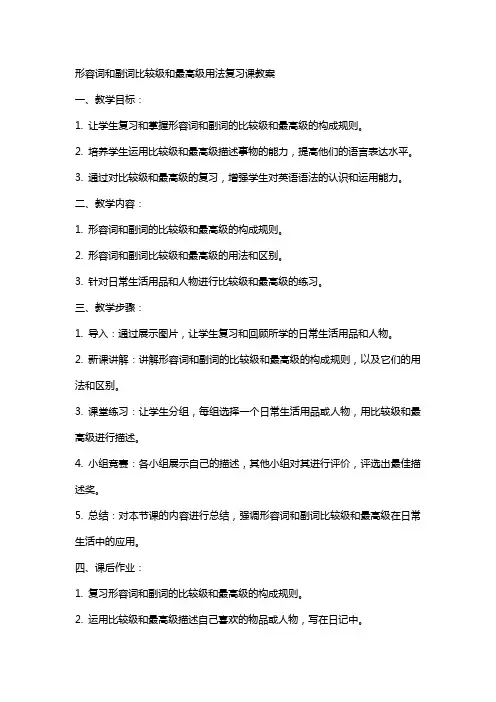
形容词和副词比较级和最高级用法复习课教案一、教学目标:1. 让学生复习和掌握形容词和副词的比较级和最高级的构成规则。
2. 培养学生运用比较级和最高级描述事物的能力,提高他们的语言表达水平。
3. 通过对比较级和最高级的复习,增强学生对英语语法的认识和运用能力。
二、教学内容:1. 形容词和副词的比较级和最高级的构成规则。
2. 形容词和副词比较级和最高级的用法和区别。
3. 针对日常生活用品和人物进行比较级和最高级的练习。
三、教学步骤:1. 导入:通过展示图片,让学生复习和回顾所学的日常生活用品和人物。
2. 新课讲解:讲解形容词和副词的比较级和最高级的构成规则,以及它们的用法和区别。
3. 课堂练习:让学生分组,每组选择一个日常生活用品或人物,用比较级和最高级进行描述。
4. 小组竞赛:各小组展示自己的描述,其他小组对其进行评价,评选出最佳描述奖。
5. 总结:对本节课的内容进行总结,强调形容词和副词比较级和最高级在日常生活中的应用。
四、课后作业:1. 复习形容词和副词的比较级和最高级的构成规则。
2. 运用比较级和最高级描述自己喜欢的物品或人物,写在日记中。
3. 预习下节课的内容,了解情态动词的用法。
五、教学评价:1. 课堂参与度:观察学生在课堂上的发言和互动情况,评价他们的参与度。
2. 练习完成情况:检查学生课堂练习的完成质量,评价他们的学习效果。
3. 课后作业:批改学生的课后作业,了解他们对课堂内容的掌握情况。
4. 情态动词测试:在下节课前进行情态动词的测试,评估学生对形容词和副词比较级和最高级的掌握程度。
六、教学策略:1. 采用任务型教学法,让学生在实际操作中复习和掌握形容词和副词的比较级和最高级。
2. 运用分组合作和竞赛机制,激发学生的学习兴趣和积极性。
3. 通过日常生活用品和人物的描述,使学生能够将所学知识运用到实际生活中。
4. 注重个体差异,给予不同水平的学生适当的指导和鼓励,使他们在课堂上都能有所收获。
形容词和副词比较级和最高级用法复习课教案第一章:形容词和副词比较级的构成和用法1.1 教学目标:让学生掌握形容词和副词比较级的构成规则。
使学生能够正确运用比较级表达事物的比较关系。
1.2 教学内容:复习形容词和副词的比较级构成规则。
举例说明形容词和副词比较级的用法。
1.3 教学活动:通过例句和练习题,让学生练习构成和运用形容词和副词的比较级。
学生分组进行练习,互相纠正和指导。
1.4 作业:完成练习题,包括填空、选择题和句子写作。
第二章:形容词和副词最高级的构成和用法2.1 教学目标:让学生掌握形容词和副词最高级的构成规则。
使学生能够正确运用最高级表达事物的最高程度。
2.2 教学内容:复习形容词和副词的最高级构成规则。
举例说明形容词和副词最高级的用法。
2.3 教学活动:通过例句和练习题,让学生练习构成和运用形容词和副词的最高级。
学生分组进行练习,互相纠正和指导。
2.4 作业:完成练习题,包括填空、选择题和句子写作。
第三章:形容词和副词比较级和最高级的区别3.1 教学目标:让学生理解形容词和副词比较级和最高级的区别。
使学生能够正确选择使用比较级和最高级。
3.2 教学内容:解释形容词和副词比较级和最高级的区别。
举例说明比较级和最高级在句子中的使用。
3.3 教学活动:通过例句和练习题,让学生区分和使用形容词和副词的比较级和最高级。
学生分组进行练习,互相纠正和指导。
3.4 作业:完成练习题,包括填空、选择题和句子写作。
第四章:形容词和副词比较级和最高级的应用4.1 教学目标:让学生能够在实际语境中运用形容词和副词比较级和最高级。
使学生能够正确使用比较级和最高级进行比较和描述。
4.2 教学内容:通过情景剧和讨论,让学生练习在实际情境中使用形容词和副词的比较级和最高级。
举例说明比较级和最高级的实际应用。
4.3 教学活动:学生分组进行情景剧表演,练习使用形容词和副词的比较级和最高级。
学生进行小组讨论,分享比较级和最高级的实际应用例子。
形容词和副词比较级、最高级教案一、教学目标:1. 让学生掌握形容词和副词的比较级、最高级的构成规则。
2. 培养学生运用比较级、最高级进行表达和交流的能力。
3. 提高学生对英语词汇的认知水平,丰富学生的词汇量。
二、教学内容:1. 形容词和副词的比较级、最高级的构成规则。
2. 形容词和副词比较级、最高级的用法和句型。
3. 常见错误分析及练习。
三、教学重点与难点:1. 形容词和副词比较级、最高级的构成规则。
2. 形容词和副词比较级、最高级的用法和句型。
3. 避免常见错误。
四、教学方法:1. 采用任务型教学法,让学生在实践中学习和运用比较级、最高级。
2. 运用直观演示、例句讲解、小组讨论等教学手段,提高学生的学习兴趣和参与度。
3. 采用错例分析法,帮助学生纠正学习中常见的错误。
五、教学过程:1. 导入:通过展示图片,引导学生观察并描述图片中的事物,激发学生的学习兴趣。
2. 讲解:讲解形容词和副词比较级、最高级的构成规则,并通过例句进行解释。
3. 练习:设计不同类型的练习题,让学生巩固所学知识。
4. 小组讨论:让学生分组讨论,运用比较级、最高级进行交流。
5. 错例分析:分析学生常见的错误,并提供正确的表达方式。
6. 总结:对本节课的内容进行总结,强调重点和难点。
7. 作业布置:布置课后作业,巩固所学知识。
六、教学评价:1. 采用形成性评价和终结性评价相结合的方式,关注学生在学习过程中的表现和进步。
2. 通过课堂练习、小组讨论、错例分析等环节,观察学生的参与程度和运用能力。
3. 课后作业的完成情况,考察学生对课堂所学知识的巩固程度。
七、教学拓展:1. 引导学生运用比较级、最高级描述生活中的人、事、物,提高学生的实际运用能力。
2. 举办小型主题活动,如演讲比赛、写作比赛等,鼓励学生大胆表达,运用比较级、最高级。
3. 推荐相关英语读物,扩大学生的词汇量,提高学生的语言素养。
八、教学资源:1. 教材:选用适合学生的英语教材,如《新概念英语》、《牛津英语》等。
形容词和副词比较级和最高级用法复习课教案一、教学目标:1. 让学生掌握形容词和副词的比较级和最高级的构成规则。
2. 培养学生运用比较级和最高级描述事物的能力。
3. 提高学生对英语比较级和最高级用法的理解和运用。
二、教学重难点:1. 形容词和副词比较级和最高级的构成规则。
2. 比较级和最高级的用法和区别。
三、教学方法:1. 任务型教学法:通过完成各种任务,让学生在实践中学习和运用比较级和最高级。
2. 情景教学法:创设各种情景,让学生在真实的语境中学习比较级和最高级。
3. 小组合作学习:鼓励学生互相讨论,共同探究比较级和最高级的用法。
四、教学准备:1. 课件:制作含有比较级和最高级用法的课件。
2. 练习题:准备一些有关比较级和最高级的练习题。
3. 小组活动材料:准备一些需要用到比较级和最高级的材料。
五、教学过程:Step 1:导入(5分钟)1. 老师通过提问方式复习形容词和副词的比较级和最高级。
2. 学生回答问题,复习比较级和最高级的构成和用法。
Step 2:讲解(10分钟)1. 老师通过示例讲解形容词和副词比较级和最高级的构成规则。
2. 学生跟随老师一起练习,加深对比较级和最高级的理解。
Step 3:练习(15分钟)1. 学生完成练习题,巩固比较级和最高级的用法。
2. 老师对学生的练习进行点评,指出错误并讲解原因。
Step 4:小组活动(15分钟)1. 学生分组,每组选择一个主题,用比较级和最高级描述主题中的事物。
2. 各组展示成果,其他组进行评价。
Step 5:总结(5分钟)1. 老师对本节课的内容进行总结。
2. 学生分享学习收获和感受。
Step 6:作业布置(5分钟)1. 学生回家后,完成课后练习题,巩固本节课所学内容。
2. 准备下一节课的预习内容。
六、教学目标:1. 让学生能够熟练运用比较级和最高级进行句子的构建和表达。
2. 培养学生对英语比较级和最高级用法的敏感度。
3. 提高学生的英语听说能力和语法运用能力。
形容词副词专项复习教学设计Review of Adjectives and Adverbs一,复习目标:知识目标:1. 复习并掌握形容词和副词的原级、比较级和最高级的构成规则、基本句型及其用法。
2. 形容词作表语和定语的用法。
3. 副词作状语的用法。
②能力目标:能正确认识自我与他人的不同,接受自我。
③情感目标:通过比较认识到自己的不足,努力弥补。
二、教学重难点中考考点1.形容词和副词的原级、比较级和最高级的构成规则、基本句型及其用法。
2.形容词作表语和定语的用法.3.副词作状语的用法。
三,教学过程Step 1 Review AimsShow the aims of this class , read together1. 复习并掌握形容词和副词的原级、比较级和最高级的构成规则、基本句型及其用法。
2. 形容词作表语和定语的用法。
3. 副词作状语的用法。
②能力目标:能正确认识自我与他人的不同,接受自我。
③情感目标:通过比较认识到自己的不足,努力弥补。
Step 2 考点一形容词1.形容词的一般用法(1).形容词+名词,形容词作定语。
如:a good girl 一个好女孩[注意]由连字符连接起来的复合形容词中的名词只能用单数形式。
如:an eight-year-old boy 一个8 岁的男孩(2).be+形容词,形容词作表语。
如:The meal is delicious.这顿饭很好吃。
(3). 不定代词+形容词,形容词作后置定语。
如:重要的事情(4). 数词+单位名词+形容词,表示长、宽、高、深以及年龄。
如:five thousand meters long 五千米长(5).the+形容词,表示一类人或物。
如:the old 老人(6). 表语形容词。
这些形容词只能位于系动词后面作表语。
如:alone, awake, alive, well(健康的), ill 等。
如:The boy is alone.(正)The alone boy is here.(误)(7). 只能作定语的形容词。
中考复习之形容词副词及其比较级(一)形容词、副词比较级、最高级规则变化:fast--________--_________ warm--________--___________hard--_______--__________ tall --_________--___________late--________--__________ big--__________--_______easy --________--________ early --_________--__________careful--_________--__________ carefully--___________--___________不规则变化:good/well --_________--_________ bad/badly --________--_________many/much --_______--_________ little -- _________ --__________far --__________--___________(二)比较级用法总结:1. He is as _______ as his younger sister.A. excitedB. exciteC. exciting2. A train is ________ than a car.A. fastB. more fastC. more fasterD. much faster3. It becomes_______ when spring comes.A. warm and warmB. more and more warm C warmer and warmer4. The _______ you work, _________ you will be.A. hard; betterB. hard; goodC. harder; the betterD. hard; the better5. Who is ___________, Tim or Tom?A. tall B more tall C tallerPractice能力提升1. I hope my school life of senior high will be _____ than that of junior high.A. more excitingB. very excitingC. as exciting asD. the most exciting2. Alex believes he will be able to play chess as________ as the computer.A. wellB. betterC. bestD. the best3. In the piano contest, my brother didn’t play well and I did _____.A. very wellB. much betterC. even worseD. very worse4. – I think Jane writes as ________ as Mike.-- So she does.A. carefulB. carefullyC. more carefullyD. more careful5. This year our school is _______ than it was last year.A. much more beautifulB. much beautifulC. the most beautifulD. beautiful (三)最高级用法总结:1. Tianjin is one of _____ cities in China.A. bigB. biggerC. the biggestD. the bigger2. Tom is the ______ in his class.A. tallerB. tallC. tallestD. the most tall3. Which do you like ________, English, math or Chinese?A. goodB. wellC. betterD. bestPractice能力提升1. Mary has three brothers. Jack is ________ of the three.A. most strongB. the strongestC. strongerD. the stronger2. Mr and Mrs Brown have got three daughters and________ is 14 years old.A. oldB. oldererC. oldestD. the oldest3. The Yellow River is one of ________ rivers in China.A. longB. longerC. longestD. the longest【中考连接】[2018青岛]1. – Do you know Shanghai is one of ______ in the world?-- Yes, it’s bigger than _______ city in China.A. the biggest city; anyB. the biggest cities; anyC. the biggest cities; any other [2017青岛]2. The students think Lesson Four is ____ of the three lessons.A. difficultB. more difficultC. most difficultD. the most difficult[2016青岛]3. Though the light came from ________ countries, it’s one of ________ inventions.A. west; usefulB. western; useC. western; the most usefulD. western; more useful [2015青岛]4. – Which is _____ season in Beijing?--I think it’s autumn.A. goodB. betterC. bestD. the best【中考连接】[2016青岛]1. – Why don’t you get yourself a job?-- That’s ____ said than done.A. easyB. easierC. the easierD. the easiest[2018 青岛]2. –I can’t afford the white dress.-- What about the orange one? The price is a little_____.A. cheaperB. higherC. lowerD. more expensive[2017青岛]3. The local guide spoke ______ she could to make the visitors understand her.A. as clear asB. as clearly asC. so clear asD. so clearly as[2015青岛]4. Alice is______ one of the twins.A. the tallerB. tallerC. tallestD. tallUnit3-4重点动词练习(中考链接):综Awin, care, reach, break, choose1. If you practice hard, you _____________ the game.2. My father always _________ about me.3. Some good sentences should __________ and written down.4. He called Mary as soon as he _________ Beijing.5. He _____________ his arm, so he can’t write now.综B1. You ate your breakfast so ________.(安静地)2. The air in Yunnan is much ________(清新的) than that in Beijing.3. He is different _________(与…不同) his brother.4. There is a ______________(比赛)between these two cities.5. The little kid is too young to take care of __________(自己).【中考新题型——完形填空】AAlice was born 1______ a strange disease. She was 2._____ to many hospital. 3_____ of the doctors knew the cause(原因) of disease. They told her parents she would go blind and deaf.Now Alice is fifteen years old. Her eyesight and hearing are 4.______ poor that she can't see or hear clearly. But she is a bright and happy girl. She says to herself, “Whatever happens, I will never give 5.______.” She hopes to enjoy her life. With her parents’help, she is traveling as 6.______ as she can. She is also sharing the interesting things she experiences along the way.She also wants to help people like her. Her dream is to help researchers find a method for her disease. If she can get 7.______, people who have the same disease may also be cured(治愈). In fact, she has 8.________ money for a foundation(基金会) fighting the disease since she was in Grade Two. Until now, she has got over $150 000!Alice thinks helping others can make her9._____ than having fun alone. She is doing her best to live her life 10.______ any regret.1. ( ) A in Bat C with2. ( ) A takes B took C taken3. ( ) A none B all C neither4. ( ) A such B so C too5. ( ) A out B up C away6. ( ) A better B many C much7. ( ) A good B well C worse8. ( ) A raised B rised C raise9. ( ) A happy B happier C happiest10. ( ) A no B nothing C withoutBA boy and a girl were playing together. The boy had a lot of small glass1._____. The girl had some candies with her. The boy told the girl that he would 2._______ her all his balls in exchange for her candies. The girl thought that was a good 3.______But the boy didn't give 4.______ of his balls to the girl. He kept the biggest and the 5.______ball in his pocket and gave the others to the girl. 6________the girl gave him all her candies.That night, the girl had a 7.______ sleep, but the boy didn't sleep well. He kept thinking whether the girl had 8._______ some candies from him.You think in the way you do things. If you don't give your hundred percent in a relationship, you’ll 9._____ keep thinking if the other person has given his or her hundred percent. This is true for any relationship.Give your hundred percent to everything you do and you'll find that you can always 10._______ a lot of happiness.1. ( ) A. balls B. cups C. bottles2. ( ) A. lend B. buy C. give3. ( ) A. answer B. idea C. reason4. ( ) A. all B. most C. some5. ( ) A. ugliest B. cheapest C. prettiest6. ( ) A. But B. So C. Or7. ( ) A. bad B. good C. light8. ( ) A. borrowed B. stolen C. hidden9. ( ) A. always B. never C. seldom10. ( )A. lose B. get C. wantN.阅读表达阅读下面短文,按要求完成各项任务。
the forms of comparative and superlativedegrees of adjectives and adverbs形容词、副词比较级与最高级的构成Part 1.Teaching objectivesI . Knowledge goals:the forms of comparative and superlative degrees of adjectivesand adverbsⅡ. Ability goals:ⅰ.Let the Ss maste r the ways about “the forms of comparativeand superlative degrees of adjectives and adverbs”.ⅱ.Motivate Ss to review and learn to compare physicalcharacteristics and abilities.Ⅲ. Moral goals:Train the Ss` abilities of right competition and comparison. Part Ⅱ.Teaching focusI. The forms of comparative and superlative degrees of adjectivesand adverbsⅡ.How to change the forms of comparative and superlative degrees of adjectives and adverbsPartⅢ.Teaching important and difficult pointsI. Lead the Ss to retell and remember the forms of comparativeand superlative degrees of adjectives and adverbsⅡ.How to train the Ss to use the forms freely.Part Ⅳ. Teaching aidsI. Multi-mediaⅡ. The blackboardⅢ. Some picturesPart Ⅴ. Teaching ProceduresStep 1 GreetingGreet the Ss and make introduction myself to teachers and Ss. Step 2 Lead-inⅰ.Show some pictures on ppt. to lead the Ss to comparesomething.ⅱ.Guide Ss to know how to change adjectives intocomparative and superlative degrees.ⅲ. Ask Ss to guess what we have in this class.Step3.PresentationⅠ.I write the key words on the Bb while Ss look at the pictures.Let`s do a guessing—game .Ss:形容词、副词比较级与最高级的构成T: You are very clever.So I show the title of this lesson“the forms of comparative and superlative degrees of adjectives and adverbs.”Ⅱ.I’ll use ppt. to present the content. Arrange some situations to help Ss understand.Ⅲ.Let the Ss to Continue look at the pictures. At the same time,I write the key words on the Bb. while Ss are watching thepictures.After watching, I’ll teach them to read the words and vocabularies on the Bb. Make sure they can read them well. then, ask the Ss :T: Do you find out the rules of these words?Ss: 1 .一般情况下直接在词尾加er或est.2.以字母e结尾的在词尾加r或st.3.以辅音字母加y结尾的变y为i再加er; est4.在重读闭音节结尾且末尾只有一个辅音字母的,要双写末尾的辅音字母再加er; estⅣ.Let the Ss to Continue look at the pictures. At the same time, I write the key words on the Bb. while Ss are watching the pictures.Ss: 多音节词和部分双音节词在原级前加more或most Ⅴ.Let the Ss to Continue look at the pictures. At the same time,I write the key words on the Bb. while Ss are watching thepictures.T: Do you find out the rules of these words?Ss: 这些是不规则变化形式。
T: Well done.So I show the irregular forms of comparative and superlative degrees of adjectives and adverbs.注:older 一般指年龄大小;My father is older than my mother.elder指长幼关系(一般修饰名词作定语); My elder brother is a driver.farther指距离更远;My home is farther than yours .further指程度深浅. I want to study English further.Step4.PracticeLet the Ss do some exercises.写出下列形容词与副词的比较级与最高级形式:long wide fat heavy slow few brightly quicklyhappy important big small new tall short oldweak strong fat hot cold thin nice highlow cheap easy heavy early tidy brightlarge happy pretty young wet long clean dirtyThen, ask Ss to ask and answer in pairs. last, I show the answers.Let the Ss to check their answers.Step5. SummaryAfter the above tasks, I have the class summarize what they havelearned in class. Students can master and use the regular andirregular forms of comparative and superlative degrees ofadjectives and adverbs.Step6. Homework1.If you can ,please make eight sentences with each of regular forms and irregular forms.2.If you can`t ,please copy the examples of practice on page17--21, three times everyone.Part Ⅵ.Blackboard design.规则变化(二)-----词前加more或most多音节词和部分双音节词在原级前加more或most构成比较级和最高级eg. beautiful—more beautiful—most beautifulimportant—more important—most important二、不规则变化对“the forms of comparative and superlativedegrees of adjectives and adverbs形容词、副词比较级与最高级的构成”的课后反思随着新课程改革的逐步深化,教师的个人能力和素质显得愈来愈主要。
教师工作中蕴含的艺术性也越来越受到家长和学生的关注。
课程改革要求教师发挥自身的创造能力,创造性的开展教学工作,,要有分析教材、使用教材、和再造教材的能力。
这就要求教师要经常给自己的日常教学注入一些活力,发挥教育机智,将灵感的闪现表现在教学设计当中。
今天我上的是形容词的比较级和最高级语法复习课。
为了完成本课的教学目标和落实教学重难点,同时为了把枯燥的语法课变得生动有吸引力,我先用了一些学生喜,欢的名星图片来导入,“投其所好”,用学生乐于接受的方式进行教学。
然后层层展开,将知识逐一落实,引导学生总结规则变化的5条规律和不规则变化形式。
还有在作业设计环节,我用运了分层教学,因材施教的原则,让各个层次的学生都学有所获。
教案精品文档。